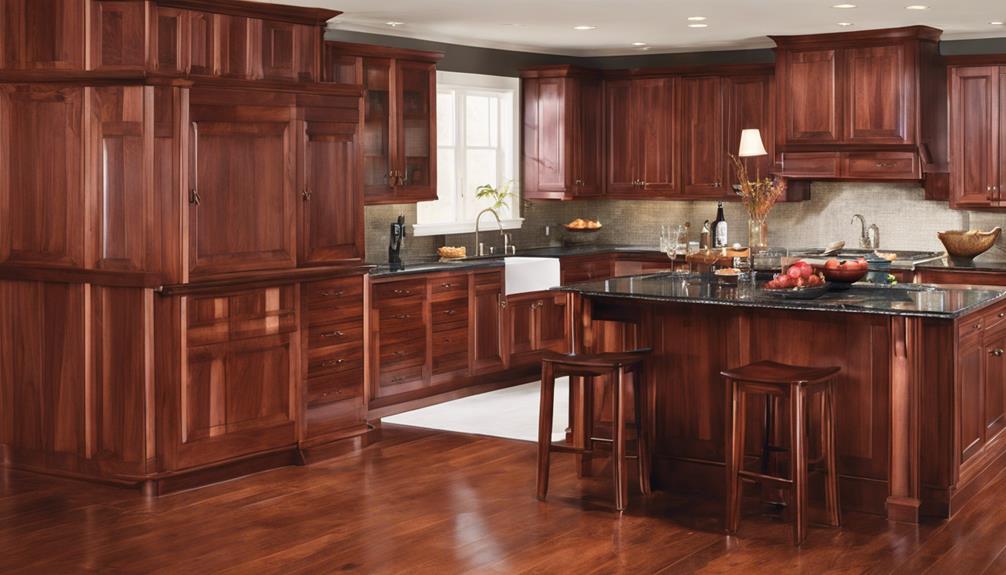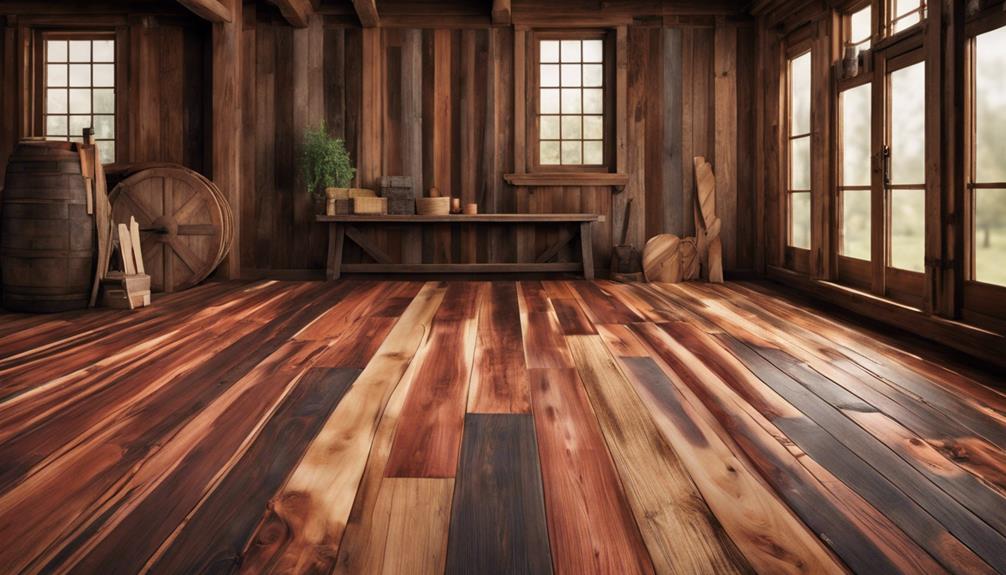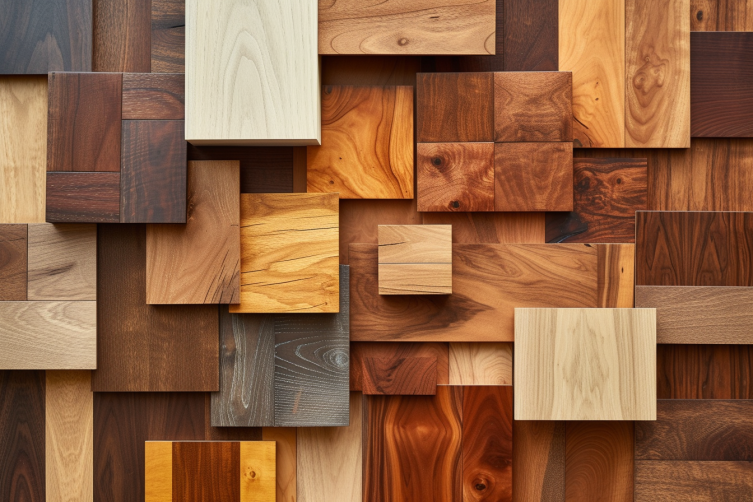When you consider the timeless charm of a finely crafted mahogany table, it’s clear why classic wood types hold a revered place in heritage carpentry projects. These materials, including ash, cherry, hard maple, and teak, offer not just durability and a unique palette of colors, but also a connection to the craftsmanship of the past.
As you explore these woods, you’ll find each has its own story, shaped by centuries of use in everything from elegant furniture to rugged ship decks. This journey into the heart of traditional woodworking isn’t just about choosing a material; it’s about embracing a legacy that continues to inspire.
Why settle for the ordinary when the extraordinary awaits your touch?
Contents
Key Takeaways
- Oak is prized for its strength, moisture resistance, and timeless appeal in traditional carpentry.
- Mahogany’s rich color palette and durability make it versatile for both indoor and outdoor heritage projects.
- Cedar and Redwood provide natural durability and are environmentally friendly options for outdoor heritage carpentry.
- The choice of wood, from oak to mahogany to cedar and redwood, impacts the aesthetic, durability, and sustainability of carpentry projects.
The Timeless Appeal of Oak

Oak’s enduring strength and distinct grain pattern have cemented its status as a timeless favorite for heritage carpentry projects. Its prominent grain and warm color tones not only add character to furniture and structures but also bring a piece of history to life in a tangible form.
Oak’s resistance to moisture and decay is a testament to its reliability, making it an ideal choice for creating long-lasting pieces that withstand the test of time in historic settings. When treated wood is mentioned, oak stands out for its ability to maintain stability and durability, enhancing its appeal for traditional joinery techniques.
Its availability and workability have solidified oak’s role in classic woodworking, underscoring its unparalleled appeal in the realm of heritage carpentry.
Mahogany: A Touch of Elegance

You’ll find mahogany’s rich color palette, from red-brown to blood-red, brings a touch of elegance to any carpentry project.
Its durability makes it a superior choice for outdoor projects, ensuring longevity and resistance to wear.
Moreover, mahogany’s versatility in design applications allows for its use in everything from fine furniture to intricate veneers, showcasing its timeless appeal in both traditional and contemporary settings.
Mahogany’s Rich Color Palette
Mahogany’s signature red-brown to blood-red color palette infuses each carpentry project with unmatched elegance and sophistication. Its versatility shines through in the crafting of fine furniture and intricate tool handles, where the wood’s deep hues and straight grain elevate the aesthetics of any piece. Mahogany’s richness is not just in color but in the tradition and timelessness it brings to heritage carpentry.
| Emotion | Mahogany Detail |
|---|---|
| Warmth | Red-brown hue |
| Depth | Blood-red tones |
| Stability | Straight grain |
| Texture | Medium feel |
| Heritage | Timeless elegance |
As you delve into your next carpentry project, remember that choosing mahogany means embracing a touch of elegance that only this classic wood can offer.
Durability in Outdoor Projects
When selecting wood for outdoor projects, few can match the durability and weather resistance of mahogany, ensuring your creations withstand the test of time with a touch of elegance. It’s not just the signature red-brown to blood-red color that adds sophistication to your outdoor spaces; mahogany’s straight grain and medium texture offer unmatched versatility, making it ideal for a range of applications, from outdoor furniture to boat decking.
Despite the higher cost, the investment in mahogany pays off in its longevity and resilience against the elements. This is particularly crucial for structures exposed to weather, such as roof rafters, where durability is paramount. Opting for mahogany means choosing a material that marries elegance with enduring strength.
Versatile Design Applications
Elevating the world of heritage carpentry, mahogany’s rich color and fine grain open a realm of versatile design applications, from elegant furniture to intricate stairways. Its signature red-brown to blood-red hue adds a touch of elegance that’s unparalleled, making it a popular choice despite its expense. The luxurious appearance and excellent workability of mahogany enable you to create timeless pieces with a distinct sense of sophistication.
Consider mahogany for your next project in:
- Fine Furniture: Its straight grain and medium texture are ideal for crafting elegant chairs, tables, and cabinets.
- Veneers and Patterns: Enhance the aesthetic of interiors with detailed mahogany veneers.
- Stairways and Caskets: For a regal touch, incorporate mahogany into grand staircases or dignified caskets, showcasing its versatile design applications in heritage carpentry.
The Versatile Beauty of Walnut

Turning your attention to walnut, you’ll discover its unique grain patterns set it apart in the realm of woodworking. Its durability ensures your projects not only look exquisite but stand the test of time.
Known for its versatility, walnut’s use in fine furniture and decorative pieces speaks to its enduring appeal and craftsmanship value.
Walnut’s Unique Grain Patterns
Walnut wood stands out for its remarkable grain patterns, which vary from straight lines to captivating waves or curls, making it a favorite among craftsmen for its aesthetic appeal and versatility. The contrast between the dark brown heartwood and lighter sapwood adds depth and visual interest to any project. Its natural luster and smooth finish elevate the elegance of high-end woodworking projects.
Consider these features that highlight walnut’s unique appeal:
- Striking Grain Patterns: From straight to wavy or curly, each piece tells a distinct story.
- Rich Color Palette: The deep browns are beautifully offset by lighter tones, creating a dynamic visual effect.
- Workability: Allows for intricate detailing and smooth carving, showcasing the wood’s distinctive textures and patterns.
Durability in Woodworking Projects
Among the plethora of wood types available for carpentry, walnut’s durability stands as a testament to its exceptional suitability for a variety of projects, from elegant furniture to enduring flooring.
As a highly durable hardwood, walnut is known for its strength and resistance to wear and tear. This makes it a popular choice for furniture making, flooring, cabinetry, and decorative elements.
Its rich, dark brown color and unique grain patterns not only add aesthetic appeal but also ensure that each piece is distinct.
Over time, walnut ages beautifully, developing a lustrous patina that enhances its visual charm.
For heritage carpentry projects that seek longevity and timeless elegance, walnut’s durable nature makes it a reliable choice, promising both functionality and unmatched beauty.
Cherishing Cherry Wood

Why is cherry wood so coveted in heritage carpentry projects? Its allure lies not just in its classic color range but also in its versatility and the elegance it brings to fine craftsmanship. When you choose cherry wood for your project, you’re selecting a material known for:
- A distinctive color palette, ranging from pinkish-brown to rich red-brown, that adds warmth and depth to any piece.
- The ability to easily craft curved designs, providing unique aesthetic appeal to furniture and architectural elements.
- Its status as a prized material due to increasing prices and limited availability, which underscores its value in traditional woodworking.
Cherry wood’s timeless appeal makes it ideal for cabinets, flooring, musical instruments, and fine furniture, elevating the sophistication of heritage carpentry works.
Pine: Rustic Charm Redefined

Pine, with its distinctive light color and prominent grain, brings a rustic charm and warmth to any heritage carpentry project, making it a versatile and affordable choice for artisans and craftsmen.
Its light weight and natural beauty are ideal for creating small wooden tables, dressers, and other household items that evoke a timeless look. Known for its easy workability, pine allows for intricate designs and details in heritage-inspired projects.
The wood’s affordability also means you can tackle larger projects without breaking the bank. Whether you’re crafting a cozy cabin vibe or looking to add a touch of tradition to your home, pine’s rustic charm redefines what it means to incorporate classic beauty into modern craftsmanship.
Cedar and Redwood: Natural Durability

Cedar and redwood stand out for their impressive natural durability, offering resistance to rot, decay, and insects, making them ideal choices for your outdoor carpentry projects. These woods aren’t only strong defenders against the elements but also come with an aesthetic appeal that enhances any project. The distinct aroma and beautiful grain patterns add to their allure, making them favorites among carpenters and woodworkers.
Here’s why you should consider them:
- Weather-resistant properties: Cedar is widely available and commonly used for fences, decks, and siding, thanks to its ability to withstand harsh weather conditions.
- Rich colors and textures: Redwood, with its reddish-brown hue, is perfect for fine woodworking and outdoor furniture.
- Sustainability: Both wood types are fast-growing and replenishable, making them sustainable choices for your heritage carpentry projects.
Conclusion
In wrapping up, you’ve ventured through the realm of classic woods, each with its unique allure and time-tested resilience. You’ve seen how oak’s robustness, mahogany’s elegance, walnut’s versatility, and cherry’s charm elevate heritage carpentry to an art.
Pine and cedar, with their rustic appeal and inherent durability, redefine the warmth of traditional designs. Embracing these woods means not just building but crafting legacies.
As you embark on your projects, remember, the wood you choose weaves the story of your creation.






